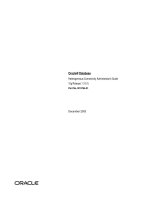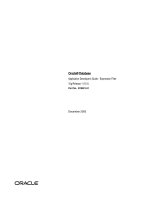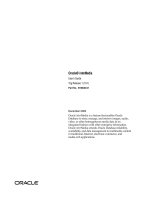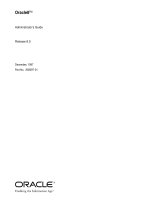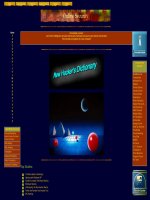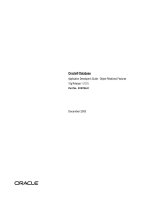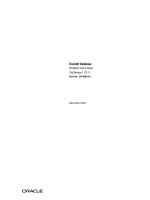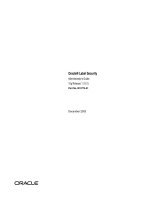Tài liệu Replication Administrator''''s Guide doc
Bạn đang xem bản rút gọn của tài liệu. Xem và tải ngay bản đầy đủ của tài liệu tại đây (2.6 MB, 364 trang )
Oracle® Streams
Replication Administrator's Guide
10g Release 1 (10.1)
Part No. B10728-01
December 2003
Oracle Streams Replication Administrator’s Guide, 10g Release 1 (10.1)
Part No. B10728-01
Copyright © 2003 Oracle Corporation. All rights reserved.
Primary Author: Randy Urbano
Graphic Artist: Valarie Moore
Contributors: Nimar Arora, Lance Ashdown, Ram Avudaiappan, Sukanya Balaraman, Neerja Bhatt,
Ragamayi Bhyravabhotla, Diego Cassinera, Debu Chatterjee, Alan Downing, Lisa Eldridge, Curt
Elsbernd, Yong Feng, Jairaj Galagali, Brajesh Goyal, Sanjay Kaluskar, Lewis Kaplan, Anand
Lakshminath, Jing Liu, Edwina Lu, Raghu Mani, Pat McElroy, Krishnan Meiyyappan, Shailendra Mishra,
Tony Morales, Bhagat Nainani, Anand Padmanaban, Kashan Peyetti, Maria Pratt, Arvind Rajaram, Viv
Schupmann, Vipul Shah, Neeraj Shodhan, Wayne Smith, Benny Souder, Jim Stamos, Janet Stern, Mahesh
Subramaniam, Bob Thome, Hung Tran, Ramkumar Venkatesan, Byron Wang, Wei Wang, James M.
Wilson, Lik Wong, David Zhang
The Programs (which include both the software and documentation) contain proprietary information of
Oracle Corporation; they are provided under a license agreement containing restrictions on use and
disclosure and are also protected by copyright, patent and other intellectual and industrial property
laws. Reverse engineering, disassembly or decompilation of the Programs, except to the extent required
to obtain interoperability with other independently created software or as specified by law, is prohibited.
The information contained in this document is subject to change without notice. If you find any problems
in the documentation, please report them to us in writing. Oracle Corporation does not warrant that this
document is error-free. Except as may be expressly permitted in your license agreement for these
Programs, no part of these Programs may be reproduced or transmitted in any form or by any means,
electronic or mechanical, for any purpose, without the express written permission of Oracle Corporation.
If the Programs are delivered to the U.S. Government or anyone licensing or using the programs on
behalf of the U.S. Government, the following notice is applicable:
Restricted Rights Notice Programs delivered subject to the DOD FAR Supplement are "commercial
computer software" and use, duplication, and disclosure of the Programs, including documentation,
shall be subject to the licensing restrictions set forth in the applicable Oracle license agreement.
Otherwise, Programs delivered subject to the Federal Acquisition Regulations are "restricted computer
software" and use, duplication, and disclosure of the Programs shall be subject to the restrictions in FAR
52.227-19, Commercial Computer Software - Restricted Rights (June, 1987). Oracle Corporation, 500
Oracle Parkway, Redwood City, CA 94065.
The Programs are not intended for use in any nuclear, aviation, mass transit, medical, or other inherently
dangerous applications. It shall be the licensee's responsibility to take all appropriate fail-safe, backup,
redundancy, and other measures to ensure the safe use of such applications if the Programs are used for
such purposes, and Oracle Corporation disclaims liability for any damages caused by such use of the
Programs.
Oracle is a registered trademark, and Oracle9i, Oracle Store, SQL*Plus, and PL/SQL are trademarks or
registered trademarks of Oracle Corporation. Other names may be trademarks of their respective
owners.
iii
Contents
Send Us Your Comments xi
Preface xiii
Audience xiv
Organization xiv
Related Documentation xvii
Conventions xviii
Documentation Accessibility xxi
Part I Streams Replication Concepts
1 Understanding Streams Replication
Overview of Streams Replication 1-2
Rules in a Streams Replication Environment 1-3
Non-Identical Replicas with Streams 1-5
Subsetting with Streams 1-5
Capture and Streams Replication 1-6
Change Capture Using a Capture Process 1-6
Change Capture Using a Custom Application 1-11
Propagation and Streams Replication 1-12
LCR Staging 1-12
LCR Propagation 1-12
iv
Apply and Streams Replication 1-14
Overview of the Apply Process 1-14
Apply Processing Options for LCRs 1-15
Considerations for Applying DML Changes to Tables 1-17
Considerations for Applying DDL Changes 1-26
Instantiation SCN and Ignore SCN for an Apply Process 1-30
The Oldest SCN for an Apply Process 1-31
Low-Watermark and High-Watermark for an Apply Process 1-32
Trigger Firing Property 1-32
2 Instantiation and Streams Replication
Overview of Instantiation and Streams Replication 2-2
Capture Process Rules and Preparation for Instantiation 2-4
DBMS_STREAMS_ADM Package Procedures Automatically Prepare Objects 2-4
When Preparing for Instantiation Is Required 2-5
Oracle Data Pump and Streams Instantiation 2-7
Data Pump Export and Object Consistency 2-7
Oracle Data Pump Import and Streams Instantiation 2-8
Original Export/Import and Streams Instantiation 2-13
The OBJECT_CONSISTENT Export Utility Parameter and Streams 2-13
Original Import Utility Parameters Relevant to Streams 2-14
3 Streams Conflict Resolution
About DML Conflicts in a Streams Environment 3-2
Conflict Types in a Streams Environment 3-2
Update Conflicts in a Streams Environment 3-3
Uniqueness Conflicts in a Streams Environment 3-3
Delete Conflicts in a Streams Environment 3-3
Foreign Key Conflicts in a Streams Environment 3-3
Conflicts and Transaction Ordering in a Streams Environment 3-4
Conflict Detection in a Streams Environment 3-5
Control Over Conflict Detection for Nonkey Columns 3-5
Rows Identification During Conflict Detection in a Streams Environment 3-6
v
Conflict Avoidance in a Streams Environment 3-6
Use a Primary Database Ownership Model 3-6
Avoid Specific Types of Conflicts 3-6
Conflict Resolution in a Streams Environment 3-8
Prebuilt Update Conflict Handlers 3-9
Custom Conflict Handlers 3-15
4 Streams Tags
Introduction to Tags 4-2
Tags and Rules Created by the DBMS_STREAMS_ADM Package 4-3
Tags and Online Backup Statements 4-6
Tags and an Apply Process 4-7
Streams Tags in a Replication Environment 4-8
Each Databases Is a Source and Destination Database for Shared Data 4-9
Primary Database Sharing Data with Several Secondary Databases 4-13
Primary Database Sharing Data with Several Extended Secondary Databases 4-20
5 Streams Heterogeneous Information Sharing
Oracle to Non-Oracle Data Sharing with Streams 5-2
Change Capture and Staging in an Oracle to Non-Oracle Environment 5-3
Change Apply in an Oracle to Non-Oracle Environment 5-3
Transformations in an Oracle to Non-Oracle Environment 5-10
Messaging Gateway and Streams 5-10
Error Handling in an Oracle to Non-Oracle Environment 5-10
Example Oracle to Non-Oracle Streams Environment 5-11
Non-Oracle to Oracle Data Sharing with Streams 5-11
Change Capture and Staging in a Non-Oracle to Oracle Environment 5-12
Change Apply in a Non-Oracle to Oracle Environment 5-12
Instantiation from a Non-Oracle Database to an Oracle Database 5-13
Non-Oracle to Non-Oracle Data Sharing with Streams 5-13
vi
Part II Configuring and Administering Streams Replication
6 Configuring Streams Replication
Creating a New Streams Single Source Environment 6-2
Adding Shared Objects to an Existing Single Source Environment 6-7
Adding a New Destination Database to a Single Source Environment 6-14
Creating a New Streams Multiple Source Environment 6-18
Configuring Populated Databases When Creating a Multiple Source Environment 6-22
Adding Shared Objects to Import Databases When Creating a New Environment 6-23
Complete the Multiple Source Environment Configuration 6-24
Adding Shared Objects to an Existing Multiple Source Environment 6-25
Configuring Populated Databases When Adding Shared Objects 6-30
Adding Shared Objects to Import Databases in an Existing Environment 6-31
Complete the Adding Objects to a Multiple Source Environment Configuration 6-33
Adding a New Database to an Existing Multiple Source Environment 6-34
Configuring Databases If the Shared Objects Already Exist at the New Database 6-37
Adding Shared Objects to a New Database 6-39
7 Managing Capture, Propagation, and Apply
Managing Capture for Streams Replication 7-2
Creating a Capture Process 7-2
Managing Supplemental Logging in a Streams Replication Environment 7-4
Managing Staging and Propagation for Streams Replication 7-8
Creating a SYS.AnyData Queue to Stage LCRs 7-9
Creating a Propagation That Propagates LCRs 7-10
Managing Apply for Streams Replication 7-12
Creating an Apply Process That Applies LCRs 7-12
Managing the Substitute Key Columns for a Table 7-14
Managing a DML Handler 7-16
Managing the DDL Handler for an Apply Process 7-20
Managing Streams Conflict Detection and Resolution 7-23
Replicating and Maintaining Tablespaces Using Streams 7-29
vii
Managing Streams Tags 7-33
Managing Streams Tags for the Current Session 7-33
Managing Streams Tags for an Apply Process 7-34
Changing the DBID or Global Name of a Source Database 7-35
Resynchronizing a Source Database in a Multiple Source Environment 7-37
Performing Database Point-in-Time Recovery in a Streams Environment 7-38
Performing Point-in-Time Recovery on the Source in a Single Source Environment 7-38
Performing Point-in-Time Recovery in a Multiple Source Environment 7-42
Performing Point-in-Time Recovery on a Destination Database 7-44
8 Performing Instantiations
Preparing Database Objects for Instantiation at a Source Database 8-2
Aborting Preparation for Instantiation at a Source Database 8-3
Instantiating Objects in a Streams Replication Environment 8-4
Instantiating Objects in a Streams Environment Using Data Pump Export/Import 8-4
Instantiating Objects in a Streams Environment Using Transportable Tablespaces 8-8
Instantiating Objects in a Streams Environment Using Original Export/Import 8-13
Instantiating an Entire Database in a Streams Environment Using RMAN 8-15
Setting Instantiation SCNs at a Destination Database 8-22
Setting Instantiation SCNs Using Export/Import 8-23
Setting Instantiation SCNs Using the DBMS_APPLY_ADM Package 8-25
9 Managing Logical Change Records (LCRs)
Requirements for Managing LCRs 9-2
Constructing and Enqueuing LCRs 9-3
Managing LCRs Containing LONG, LONG RAW, or LOB Columns 9-9
Requirements for Processing LCRs Containing LONG and LONG RAW Columns 9-10
Requirements for Constructing and Processing LCRs Containing LOB Columns 9-11
Apply Process Behavior for LCRs Containing LOBs 9-13
Example Script for Constructing and Enqueuing LCRs Containing LOBs 9-14
viii
10 Monitoring Streams Replication
Monitoring Supplemental Logging 10-2
Displaying Supplemental Log Groups at a Source Database 10-2
Displaying Database Supplemental Logging Specifications 10-4
Monitoring an Apply Process in a Streams Replication Environment 10-4
Displaying the Substitute Key Columns Specified at a Destination Database 10-5
Displaying Information About DML and DDL Handlers 10-6
Displaying Information About Conflict Detection 10-8
Displaying Information About Update Conflict Handlers 10-9
Monitoring Buffered Queues 10-10
Determining the Number of LCRs in Each Buffered Queue 10-11
Viewing the Capture Processes For the LCRs in Each Buffered Queue 10-12
Displaying General Information About Propagations That Send Captured Events 10-14
Displaying the Number of Events and Bytes Sent By Propagations 10-15
Displaying Performance Statistics For Propagations That Send Captured Events 10-16
Viewing the Propagations Dequeuing LCRs From Each Buffered Queue 10-17
Displaying Performance Statistics For Propagations That Receive Captured Events 10-19
Viewing the Apply Processes Dequeuing LCRs From Each Buffered Queue 10-20
Monitoring Streams Tags 10-21
Displaying the Tag Value for the Current Session 10-21
Displaying the Default Tag Value for Each Apply Process 10-22
Monitoring Instantiation 10-23
Determining Which Database Objects Are Prepared for Instantiation 10-23
Determining the Tables for Which an Instantiation SCN Has Been Set 10-24
Running Flashback Queries in a Streams Replication Environment 10-26
11 Troubleshooting Streams Replication
Is the Apply Process Encountering Contention? 11-2
Is the Apply Process Waiting for a Dependent Transaction? 11-4
Is an Apply Server Performing Poorly for Certain Transactions? 11-5
Are There Any Apply Errors in the Error Queue? 11-7
ORA-01031 Insufficient Privileges 11-7
ORA-01403 No Data Found 11-8
ORA-23605 Invalid Value for Streams Parameter 11-10
ORA-23607 Invalid Column 11-11
ix
ORA-24031 Invalid Value, parameter_name Should Be Non-NULL 11-11
ORA-26687 Instantiation SCN Not Set 11-12
ORA-26688 Missing Key in LCR 11-14
ORA-26689 Column Type Mismatch 11-15
Part III Example Replication Environments
12 Simple Single Source Replication Example
Overview of the Simple Single Source Replication Example 12-2
Prerequisites 12-3
13 Single Source Heterogeneous Replication Example
Overview of the Single Source Heterogeneous Replication Example 13-2
Prerequisites 13-5
Add Objects to an Existing Streams Replication Environment 13-7
Add a Database to an Existing Streams Replication Environment 13-9
14 Multiple Source Replication Example
Overview of the Multiple Source Databases Example 14-2
Prerequisites 14-5
Part IV Appendixes
A Migrating Advanced Replication to Streams
Overview of the Migration Process A-2
Migration Script Generation and Use A-2
Modification of the Migration Script A-3
Actions Performed by the Generated Script A-3
Migration Script Errors A-4
Manual Migration of Updatable Materialized Views A-4
Advanced Replication Elements That Cannot Be Migrated to Streams A-4
Preparing to Generate the Migration Script A-5
x
Generating and Modifying the Migration Script A-5
Example Advanced Replication Environment to be Migrated to Streams A-6
Performing the Migration for Advanced Replication to Streams A-12
Before Executing the Migration Script A-12
Executing the Migration Script A-14
After Executing the Script A-15
Recreating Master Sites to Retain Materialized View Groups A-17
Index
xi
Send Us Your Comments
Oracle Streams Replication Administrator’s Guide, 10g Release 1 (10.1)
Part No. B10728-01
Oracle Corporation welcomes your comments and suggestions on the quality and usefulness of this
document. Your input is an important part of the information used for revision.
■ Did you find any errors?
■ Is the information clearly presented?
■ Do you need more information? If so, where?
■ Are the examples correct? Do you need more examples?
■ What features did you like most?
If you find any errors or have any other suggestions for improvement, please indicate the document
title and part number, and the chapter, section, and page number (if available). You can send com-
ments to us in the following ways:
■ Electronic mail:
■ FAX: (650) 506-7227 Attn: Server Technologies Documentation Manager
■ Postal service:
Oracle Corporation
Server Technologies Documentation
500 Oracle Parkway, Mailstop 4op11
Redwood Shores, CA 94065
USA
If you would like a reply, please give your name, address, telephone number, and (optionally) elec-
tronic mail address.
If you have problems with the software, please contact your local Oracle Support Services.
xii
xiii
Preface
Oracle Streams Replication Administrator’s Guide describes the features and
functionality of Streams that can be used for data replication. This document
contains conceptual information about Streams replication, along with information
about configuring and managing a Streams replication environment.
This preface contains these topics:
■ Audience
■ Organization
■ Related Documentation
■ Conventions
■ Documentation Accessibility
xiv
Audience
Oracle Streams Replication Administrator’s Guide is intended for database
administrators who create and maintain Streams replication environments. These
administrators perform one or more of the following tasks:
■ Plan for a Streams replication environment
■ Configure a Streams replication environment
■ Configure conflict resolution in a Streams replication environment
■ Administer a Streams replication environment
■ Monitor a Streams replication environment
■ Perform necessary troubleshooting activities for a Streams replication
environment
To use this document, you need to be familiar with relational database concepts,
SQL, distributed database administration, general Oracle Streams concepts,
Advanced Queuing concepts, PL/SQL, and the operating systems under which you
run a Streams environment.
Organization
This document contains:
Part I, "Streams Replication Concepts"
Contains chapters that describe conceptual information relating to Streams.
Chapter 1, "Understanding Streams Replication"
Contains general conceptual information about Streams replication. Includes
information about change capture, propagation, change apply, and instantiation in a
Streams replication environment.
Chapter 2, "Instantiation and Streams Replication"
Contains conceptual information about instantiation and Streams replication.
Includes conceptual information about preparing database objects for instantiation
and information about using various utilities to perform instantiations.
xv
Chapter 3, "Streams Conflict Resolution"
Contains conceptual information about conflicts. Includes information about the
possible types of conflicts, conflict detection, conflict avoidance, and conflict
resolution in Streams environments.
Chapter 4, "Streams Tags"
Contains conceptual information about Streams tags. Includes information about
how tag values are used in rules, how a tag value can be set for an apply process,
and how to avoid change cycling using tags.
Chapter 5, "Streams Heterogeneous Information Sharing"
Contains conceptual information about heterogeneous information sharing using
Streams. Includes information about sharing information in an Oracle database
with a non-Oracle database, sharing information in a non-Oracle database with an
Oracle database, and using Streams to share information between two non-Oracle
databases.
Part II, "Configuring and Administering Streams Replication"
Contains chapters that illustrate example environments.
Chapter 6, "Configuring Streams Replication"
Contains information about configuring a single source and multiple source
Streams replication environment. Also includes instructions for adding objects and
databases to an existing Streams environment.
Chapter 7, "Managing Capture, Propagation, and Apply"
Contains information about managing capture processes, propagations, and apply
processes in a Streams replication environment. Also includes instructions for
managing Streams tags, and for performing database point-in-time recovery at a
destination database in a Streams environment.
Chapter 8, "Performing Instantiations"
Contains contains instructions for performing instantiations in a Streams replication
environment. Database objects must be instantiated at a destination database before
changes to these objects can be replicated.
xvi
Chapter 9, "Managing Logical Change Records (LCRs)"
Contains instructions for managing logical change records (LCRs) in a Streams
replication environment. Specifically, this chapter includes requirements for
managing LCRs, instructions for constructing LCRs, and information about
managing LCRs that contain LONG, LONG RAW, or LOB column data.
Chapter 10, "Monitoring Streams Replication"
Contains information about monitoring a Streams replication environment. This
chapter contains example queries that you may want to use to monitor your
Streams replication environment.
Chapter 11, "Troubleshooting Streams Replication"
Contains information about identifying and correcting common apply process
problems in a Streams replication environment.
Part III, "Example Replication Environments"
Contains chapters that illustrate example environments.
Chapter 12, "Simple Single Source Replication Example"
Contains a step by step example that configures a simple single source replication
environment using Streams.
Chapter 13, "Single Source Heterogeneous Replication Example"
Contains a step by step example that configures a single source heterogeneous
replication environment using Streams. Also contains step by step examples for
adding objects and databases to this environment.
Chapter 14, "Multiple Source Replication Example"
Contains a step by step example that configures a multiple source replication
environment using Streams.
Part IV, "Appendixes"
Contains chapters that illustrate example environments.
Appendix A, "Migrating Advanced Replication to Streams"
Contains information about migrating an Advanced Replication environment to a
Streams environment. This chapter provides a conceptual overview of the steps in
this process and documents each step with procedures and examples.
xvii
Related Documentation
For more information, see these Oracle resources:
■ Oracle Streams Concepts and Administration
■ Oracle Database Concepts
■ Oracle Database Administrator's Guide
■ Oracle Database SQL Reference
■ PL/SQL Packages and Types Reference
■ PL/SQL User's Guide and Reference
■ Oracle Database Utilities
■ Oracle Database Heterogeneous Connectivity Administrator's Guide
■ Streams online help for the Streams tool in the Oracle Enterprise Manager
Console
You may find more information about a particular topic in the other documents in
the Oracle documentation set.
Oracle error message documentation is only available in HTML. If you only have
access to the Oracle Documentation CD, you can browse the error messages by
range. Once you find the specific range, use your browser's "find in page" feature to
locate the specific message. When connected to the Internet, you can search for a
specific error message using the error message search feature of the Oracle online
documentation.
Many of the examples in this book use the sample schemas of the seed database,
which is installed by default when you install Oracle. Refer to Oracle Database
Sample Schemas for information on how these schemas were created and how you
can use them yourself.
Printed documentation is available for sale in the Oracle Store at
/>To download free release notes, installation documentation, white papers, or other
collateral, please visit the Oracle Technology Network (OTN). You must register
online before using OTN; registration is free and can be done at
/>xviii
If you already have a username and password for OTN, then you can go directly to
the documentation section of the OTN Web site at
/>In addition, you can find resources related to Oracle Streams at
/>Conventions
This section describes the conventions used in the text and code examples of this
documentation set. It describes:
■ Conventions in Text
■ Conventions in Code Examples
Conventions in Text
We use various conventions in text to help you more quickly identify special terms.
The following table describes those conventions and provides examples of their use.
Convention Meaning Example
Bold Bold typeface indicates terms that are
defined in the text or terms that appear in
a glossary, or both.
When you specify this clause, you create an
index-organized table.
Italics Italic typeface indicates book titles or
emphasis.
Oracle Database Concepts
Ensure that the recovery catalog and target
database do not reside on the same disk.
UPPERCASE
monospace
(fixed-width)
font
Uppercase monospace typeface indicates
elements supplied by the system. Such
elements include parameters, privileges,
datatypes, RMAN keywords, SQL
keywords, SQL*Plus or utility commands,
packages and methods, as well as
system-supplied column names, database
objects and structures, usernames, and
roles.
You can specify this clause only for a NUMBER
column.
You can back up the database by using the
BACKUP command.
Query the TABLE_NAME column in the USER_
TABLES data dictionary view.
Use the DBMS_STATS.GENERATE_STATS
procedure.
xix
Conventions in Code Examples
Code examples illustrate SQL, PL/SQL, SQL*Plus, or other command-line
statements. They are displayed in a monospace (fixed-width) font and separated
from normal text as shown in this example:
SELECT username FROM dba_users WHERE username = 'MIGRATE';
The following table describes typographic conventions used in code examples and
provides examples of their use.
lowercase
monospace
(fixed-width)
font
Lowercase monospace typeface indicates
executables, filenames, directory names,
and sample user-supplied elements. Such
elements include computer and database
names, net service names, and connect
identifiers, as well as user-supplied
database objects and structures, column
names, packages and classes, usernames
and roles, program units, and parameter
values.
Note: Some programmatic elements use a
mixture of UPPERCASE and lowercase.
Enter these elements as shown.
Enter sqlplus to open SQL*Plus.
The password is specified in the orapwd file.
Back up the datafiles and control files in the
/disk1/oracle/dbs directory.
The department_id, department_name,
and location_id columns are in the
hr.departments table.
Set the QUERY_REWRITE_ENABLED
initialization parameter to true.
Connect as oe user.
The JRepUtil class implements these
methods.
lowercase
italic
monospace
(fixed-width)
font
Lowercase italic monospace font
represents placeholders or variables.
You can specify the parallel_clause.
Run Uold_release.SQL where old_
release refers to the release you installed
prior to upgrading.
Convention Meaning Example
[ ] Brackets enclose one or more optional
items. Do not enter the brackets.
DECIMAL (digits [ , precision ])
{ } Braces enclose two or more items, one of
which is required. Do not enter the braces.
{ENABLE | DISABLE}
| A vertical bar represents a choice of two
or more options within brackets or braces.
Enter one of the options. Do not enter the
vertical bar.
{ENABLE | DISABLE}
[COMPRESS | NOCOMPRESS]
Convention Meaning Example
xx
Horizontal ellipsis points indicate either:
■ That we have omitted parts of the
code that are not directly related to
the example
■ That you can repeat a portion of the
code
CREATE TABLE AS subquery;
SELECT col1, col2, , coln FROM
employees;
.
.
.
Vertical ellipsis points indicate that we
have omitted several lines of code not
directly related to the example.
SQL> SELECT NAME FROM V$DATAFILE;
NAME
/fsl/dbs/tbs_01.dbf
/fs1/dbs/tbs_02.dbf
.
.
.
/fsl/dbs/tbs_09.dbf
9 rows selected.
Other notation You must enter symbols other than
brackets, braces, vertical bars, and ellipsis
points as shown.
acctbal NUMBER(11,2);
acct CONSTANT NUMBER(4) := 3;
Italics Italicized text indicates placeholders or
variables for which you must supply
particular values.
CONNECT SYSTEM/system_password
DB_NAME = database_name
UPPERCASE Uppercase typeface indicates elements
supplied by the system. We show these
terms in uppercase in order to distinguish
them from terms you define. Unless terms
appear in brackets, enter them in the
order and with the spelling shown.
However, because these terms are not
case sensitive, you can enter them in
lowercase.
SELECT last_name, employee_id FROM
employees;
SELECT * FROM USER_TABLES;
DROP TABLE hr.employees;
lowercase Lowercase typeface indicates
programmatic elements that you supply.
For example, lowercase indicates names
of tables, columns, or files.
Note: Some programmatic elements use a
mixture of UPPERCASE and lowercase.
Enter these elements as shown.
SELECT last_name, employee_id FROM
employees;
sqlplus hr/hr
CREATE USER mjones IDENTIFIED BY ty3MU9;
Convention Meaning Example
xxi
Documentation Accessibility
Our goal is to make Oracle products, services, and supporting documentation
accessible, with good usability, to the disabled community. To that end, our
documentation includes features that make information available to users of
assistive technology. This documentation is available in HTML format, and contains
markup to facilitate access by the disabled community. Standards will continue to
evolve over time, and Oracle is actively engaged with other market-leading
technology vendors to address technical obstacles so that our documentation can be
accessible to all of our customers. For additional information, visit the Oracle
Accessibility Program Web site at
/>Accessibility of Code Examples in Documentation JAWS, a Windows screen
reader, may not always correctly read the code examples in this document. The
conventions for writing code require that closing braces should appear on an
otherwise empty line; however, JAWS may not always read a line of text that
consists solely of a bracket or brace.
Accessibility of Links to External Web Sites in Documentation This
documentation may contain links to Web sites of other companies or organizations
that Oracle does not own or control. Oracle neither evaluates nor makes any
representations regarding the accessibility of these Web sites.
xxii
Part I
Streams Replication Concepts
This part describes conceptual information about Streams replication and contains
the following chapters:
■ Chapter 1, "Understanding Streams Replication"
■ Chapter 2, "Instantiation and Streams Replication"
■ Chapter 3, "Streams Conflict Resolution"
■ Chapter 4, "Streams Tags"
■ Chapter 5, "Streams Heterogeneous Information Sharing"
Understanding Streams Replication 1-1
1
Understanding Streams Replication
This chapter contains conceptual information about Streams replication. This
chapter contains these topics:
■ Overview of Streams Replication
■ Capture and Streams Replication
■ Propagation and Streams Replication
■ Apply and Streams Replication
See Also: Oracle Streams Concepts and Administration for general
information about Oracle Streams. This document assumes that
you understand the concepts described in Oracle Streams Concepts
and Administration.
